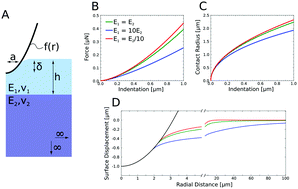Quantitative mechanical analysis of indentations on layered, soft elastic materials†
Abstract
Atomic force microscopy (AFM) is becoming an increasingly popular method for studying cell mechanics, however the existing analysis tools for determining the elastic modulus from indentation experiments are unable to quantitatively account for mechanical heterogeneity commonly found in biological samples. In this work, we numerically calculated force–indentation curves onto two-layered elastic materials using an analytic model. We found that the effect of the underlying substrate can be quantitatively predicted by the mismatch in elastic moduli and the homogeneous-case contact radius relative to the layer height for all tested probe geometries. The effect is analogous to one-dimensional Hookean springs in series and was phenomenologically modeled to obtain an approximate closed-form equation for the indentation force onto a two-layered elastic material which is accurate for up to two orders of magnitude mismatch in Young's modulus when the contact radius is less than the layer height. We performed finite element analysis simulations to verify the model and AFM microindentation experiments and macroindentation experiments to demonstrate its ability to deconvolute the Young's modulus of each layer. The model can be broadly used to quantify and serve as a guideline for designing and interpreting indentation experiments into mechanically heterogeneous samples.



 Please wait while we load your content...
Please wait while we load your content...